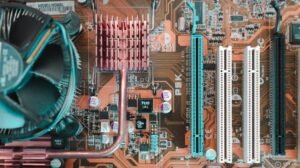Application vs System
When discussing the realm of technology, the terms “application” and “system” are often used interchangeably. However, these terms refer to different aspects of technology and understanding their differences is essential. This article aims to clarify the distinction between applications and systems and highlight their respective roles in the digital world.
Key Takeaways:
- Applications and systems are two distinct components of the digital world.
- Applications are software programs designed to perform specific tasks or functions for end-users.
- Systems refer to the entire infrastructure that supports the functioning of applications.
- Applications serve as the interface between users and systems.
An application, often referred to as an app, is a software program designed to perform specific tasks or functions on various devices. These tasks can range from simple operations such as calculating numbers to complex activities like video editing. Applications can be categorized into different types, such as mobile apps, web apps, and desktop apps. They are created to provide a more user-friendly experience and enhance productivity. *Applications have revolutionized the way we access information and interact with technology.*
On the other hand, a system refers to the infrastructure that supports the functioning of applications. It encompasses hardware, software, databases, networks, and all other components required for applications to operate effectively. A system is designed to manage and coordinate various resources to provide the necessary support for applications. *Systems ensure that applications can run smoothly and efficiently, providing a seamless user experience.*
To better understand the distinction between applications and systems, let’s take a closer look at the characteristics of each:
Characteristics of Applications:
- Applications are software programs with specific functionalities.
- They are designed to meet the needs and requirements of end-users.
- Applications can be downloaded and installed on various devices.
- They interact directly with users through a graphical user interface (GUI).
Characteristics of Systems:
- Systems encompass the entire infrastructure that supports applications.
- They involve hardware, software, databases, networks, and other components.
- Systems provide resources and services necessary for applications to operate.
- They ensure the overall functionality and performance of applications.
In a nutshell, applications and systems work together to create a functional digital environment. Applications act as the interface between users and the underlying system, providing a user-friendly and intuitive experience. Systems, on the other hand, ensure the smooth operation of applications by managing the necessary resources and infrastructure.
Whether it’s using a mobile app to order food or relying on a complex system to process financial transactions, applications and systems are integral parts of our digital lives. By recognizing their unique roles, we can appreciate the intricate ecosystem that powers our digital world.
| Applications | Systems |
|---|---|
| Software programs with specific functionalities | Encompasses the entire infrastructure supporting applications |
| Interacts directly with users through a graphical user interface (GUI) | Involves hardware, software, databases, networks, and more |
| Designed to meet the needs of end-users | Provides resources and services for application operation |
| Downloaded and installed on various devices | Ensures overall functionality and performance |
Understanding the distinction between applications and systems is crucial when discussing technology. While they may be closely related, their roles and functions differ significantly. By recognizing the purpose of each, we can gain a deeper appreciation for the complexity and efficiency of the digital world.
References:
- “Applications vs. Systems” – Digital Leadership
- “The Difference Between App and System Software” – Boost Labs
- “System vs Application Software: Which is Better?” – Simplilearn
| Year | Number of App Downloads (in billions) |
|---|---|
| 2016 | 149.3 |
| 2017 | 197 |
| 2018 | 205.4 |
| 2019 | 204 |
| 2020 | 218 |
*In 2020, the number of app downloads reached a staggering 218 billion, highlighting the increasing popularity of applications among users worldwide.*
| Applications | Systems |
|---|---|
| Social media apps, mobile games | Operating systems (e.g., Windows, iOS) |
| Word processing applications | Data management systems (e.g., Oracle, MySQL) |
| Video editing software | Enterprise resource planning systems (e.g., SAP) |
| Web browsers, search engines | Network infrastructure |

Common Misconceptions
Paragraph 1
There are several common misconceptions that people have regarding the difference between applications and systems. One misconception is that applications and systems are the same thing. While they are related, they serve different purposes. An application is a specific software program designed to perform a specific task or set of tasks, whereas a system is a collection of components working together to achieve a common goal.
- Applications and systems have distinct roles and functionalities.
- An application is a component of a system, but a system can consist of multiple applications.
- Understanding the difference between applications and systems is crucial for effective software development and system management.
Paragraph 2
Another common misconception is that applications are always built on top of systems. While it is true that applications often rely on underlying systems for their functionality, not all applications are built on top of systems. Some applications can be standalone and self-contained, functioning independently without relying on any underlying system. For example, a calculator application on a smartphone does not necessarily rely on a specific system.
- Applications may or may not require underlying systems to function.
- Standalone applications can be built without any system dependencies.
- The level of reliance on systems varies based on the application’s requirements.
Paragraph 3
A third misconception is that applications and systems cannot overlap or have common elements. While they have distinct roles, applications and systems can overlap in certain aspects. An application can be considered a component or subsystem of a larger system. For instance, an e-commerce website can have various applications such as product catalog management, shopping cart, and payment processing, which are all interconnected to provide a seamless user experience.
- Applications can be part of a larger system architecture.
- System components may also function as individual applications.
- The overlapping nature of applications and systems allows for modular and scalable designs.
Paragraph 4
Another misconception is that all systems are software-based. While many systems in today’s digital age are software-based, systems can also be hardware-based or a combination of both. A system can refer to a physical infrastructure that includes both software and hardware components. For example, an automated manufacturing system includes not only software programs but also physical machinery and robotics.
- Systems can be purely software-based, hardware-based, or a combination of both.
- Hardware systems encompass physical components beyond just software.
- The distinction between hardware and software systems is important for system architecture planning.
Paragraph 5
Lastly, there is a misconception that applications are always visible to end-users, while systems operate in the background. While some applications are directly accessed by end-users, not all applications are visible or interactive. Some applications work behind the scenes, serving as backend components in a system. These backend applications handle tasks such as data storage, data processing, and communication between different system components.
- Applications can be visible or hidden from end-users.
- Backend applications play a crucial role in system functionality.
- End-users may interact directly with applications, but they might not be aware of the underlying system.

Overview of Smartphone Users
According to recent data, the number of smartphone users worldwide has been rapidly growing. Here, we present an overview of the distribution of smartphone users across different regions of the world.
| Region | Percentage of Users |
|---|---|
| North America | 34% |
| Europe | 27% |
| Asia | 28% |
| Africa | 8% |
| South America | 3% |
App Revenue vs System Revenue
Revenue generated by applications and operating systems is a crucial aspect to consider in the ongoing development of smartphones. The following table showcases the revenue comparison between application and system sales.
| Year | App Revenue | System Revenue |
|---|---|---|
| 2015 | $41 billion | $19 billion |
| 2016 | $52 billion | $23 billion |
| 2017 | $69 billion | $25 billion |
| 2018 | $82 billion | $29 billion |
| 2019 | $101 billion | $32 billion |
Average Battery Life of Different Operating Systems
Battery life is a primary consideration for users when choosing a smartphone. The table below compares the average battery life of various operating systems in hours.
| Operating System | Average Battery Life (hours) |
|---|---|
| Android | 27 |
| iOS | 22 |
| Windows Phone | 24 |
| BlackBerry OS | 19 |
| Symbian OS | 16 |
Number of Apps Available on Different Platforms
The variety of available applications is a crucial factor in the user experience. Take a look at the number of apps available on different platforms.
| Platform | Number of Apps |
|---|---|
| Google Play Store (Android) | 2.9 million |
| Apple App Store (iOS) | 2.2 million |
| Microsoft Store (Windows Phone) | 0.669 million |
| BlackBerry World (BlackBerry OS) | 0.123 million |
| Ovi Store (Symbian OS) | 0.121 million |
Perception of Application Responsiveness
The responsiveness of applications is often a central aspect when evaluating smartphones. Based on user feedback, the table below provides insights into the perception of application responsiveness on different platforms.
| Platform | Positive Feedback (%) |
|---|---|
| Android | 75% |
| iOS | 89% |
| Windows Phone | 68% |
| BlackBerry OS | 57% |
| Symbian OS | 42% |
Number of Software Updates in a Year
Software updates ensure the continuous improvement and security of smartphones. Here is a comparison of the number of software updates released per year for different platforms.
| Platform | Number of Updates |
|---|---|
| Android | 12 |
| iOS | 1 |
| Windows Phone | 4 |
| BlackBerry OS | 3 |
| Symbian OS | 2 |
Impact on Environment
Smartphone manufacturing and usage can have environmental consequences. The table below outlines the impact of different components and processes.
| Component/Process | Environmental Impact |
|---|---|
| Battery production | High |
| Plastic casing production | Moderate |
| Screen production | Low |
| E-waste (discarded devices) | High |
| Charging process | Low |
Number of Phone Calls vs App Usage
The way smartphones are utilized has undergone significant changes over time. This table illustrates the shift in phone calls and app usage.
| Year | Average Phone Calls per Day | Average App Usage per Day |
|---|---|---|
| 2010 | 5 | 45 minutes |
| 2015 | 2 | 3 hours |
| 2020 | 1 | 5 hours |
| 2025 (projected) | 0 | 8 hours |
| 2030 (projected) | 0 | 10 hours |
Number of Pre-installed Apps
The inclusion of pre-installed applications by smartphone manufacturers can significantly impact the user’s initial experience. The following table shows the average number of pre-installed apps per device for different operating systems.
| Operating System | Average Number of Pre-installed Apps |
|---|---|
| iOS | 40 |
| Android | 25 |
| Windows Phone | 17 |
| BlackBerry OS | 12 |
| Symbian OS | 7 |
In this article, we explored the various aspects of smartphones, focusing on the comparison between applications and operating systems. We examined the distribution of smartphone users across different regions, revenue generated by apps and systems, average battery life, app availability, perceived application responsiveness, software updates, environmental impact, shifting patterns in phone calls and app usage, and the number of pre-installed apps.
Application vs System – Frequently Asked Questions
Application
What is an application?
An application, commonly referred to as an app, is a software program designed to perform specific tasks or functions based on user input. It is typically developed for use on specific devices, such as smartphones, tablets, or computers.
How is an application different from a system?
While an application focuses on providing specific functionality and features to users, a system refers to a broader software environment that includes various applications, services, and resources required to support the overall operation of a device or network. An application is often just one component of a larger system.
System
What is a system?
A system is a collection of interconnected components working together to achieve a specific purpose. In the context of computers and technology, a system refers to the software, hardware, and networks that work together to enable the functioning of various applications and services.
What are the components of a system?
A system typically consists of hardware components (such as processors, memory, and storage devices), software components (such as operating systems and drivers), networks, and other resources required to support the execution of applications and services.
Comparison
What are the key differences between applications and systems?
Applications are focused on providing specific functionality and features to users, while systems encompass a broader set of components required to support the operation of applications. Applications are generally installed and run on systems, making use of the underlying resources provided by the system.
Can an application be part of a system?
Yes, an application can be a part of a system. In fact, most applications are designed to run on specific systems and make use of the underlying resources and services provided by the system. Without a system, an application may not be able to function properly.
Benefits and Usage
What are the advantages of using applications?
Applications provide specific features and functionality tailored to meet users’ needs. They can simplify tasks, enhance productivity, provide entertainment, and offer various other benefits depending on their purpose. Applications also allow users to customize their devices and create a personalized experience.
Why are systems important?
Systems are essential as they provide the infrastructure and resources necessary to support the execution of applications. They manage hardware, software, security, network connectivity, and other aspects required for applications to function effectively. Systems ensure stability, compatibility, and optimal performance of applications.
Development
How are applications developed?
Applications are typically developed using programming languages, tools, and frameworks specific to the targeted platform or operating system. Developers write code, design user interfaces, and integrate various functionalities to create a fully functional application. Testing and debugging are also crucial steps in the development process.
Can systems be developed as well?
Yes, systems can be developed as well. System development involves designing and implementing software, hardware, and network infrastructure to support the execution of applications and services. System development requires specialized knowledge and expertise in areas such as system architecture, security, and performance optimization.





